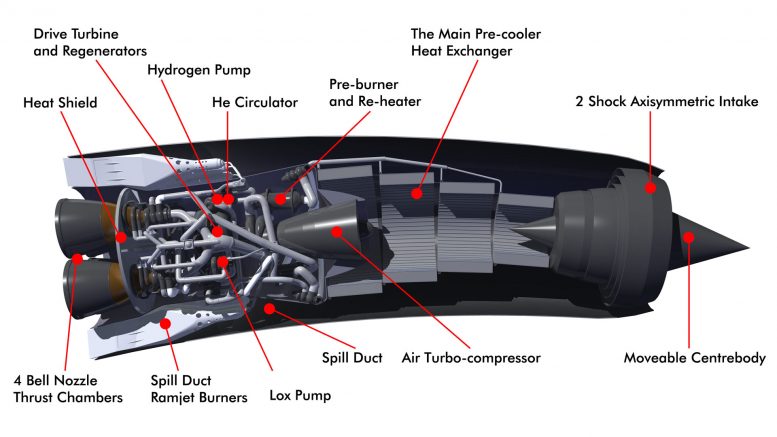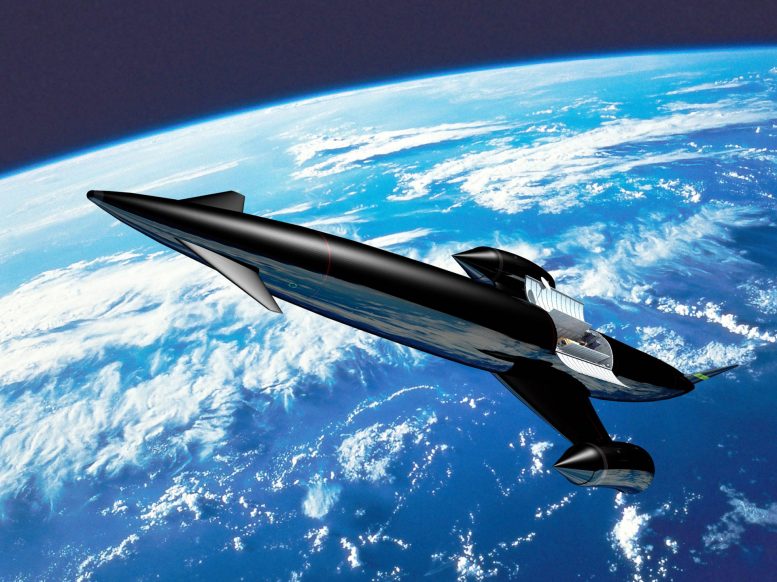The UK government will invest £60 million towards the development of the world’s first air-breathing rocket engine, the SABRE.
Through the UK Space Agency, the Government is set to invest £60 million in the development of the SABRE – a British-designed rocket engine which could revolutionize the fields of propulsion and launcher technology, and significantly reduce the costs of accessing space.
ABRE has the potential to create 21,000 high-value engineering and manufacturing jobs; maximize the UK’s access to a conservatively estimated £13.8 billion launcher market over the next thirty years; and provide economic benefits from spill-over technology markets.
Built by UK company Reaction Engines (REL), the unique engine is designed to extract the oxygen it needs for low atmosphere flight from the air itself, paving the way for a new generation of spaceplanes which would be lighter, reusable, and able to take off and launch from conventional airport runways.
Reaction Engines’ concept for an 84m-long (276ft-long), unpiloted vehicle called Skylon would be one such spaceplane, doing the job of a big rocket but operating like an aeroplane. The project, which has already successfully passed a UK Space Agency technical assessment, would provide reliable access to space and be capable of delivering payloads of up to 15 tonnes into Low Earth Orbit at about 1/50th of the cost of traditional expendable launch vehicles, such as rockets.
Minister for Universities and Science David Willetts, said:
“SABRE has the potential to completely transform how we currently access space whilst further boosting the burgeoning UK space sector. By supporting this breakthrough technology we are giving the UK a leading position in a growing market of new generation launchers and removing one of the main barriers to the growth of commercial activity in space.”
Alan Bond, who founded Reaction Engines and has led the research for over 20 years, added:
“This significant investment in British high-tech technology is a fantastic shot in the arm for the UK aerospace and space sectors, as well as the broader economy. Thanks to the Government’s support, Reaction Engines Ltd – a private company, and a great example of British enterprise – will now be able to move to the next phase in the development of its engine and heat management technology, bringing much-needed jobs and investment to the UK. Our proven revolutionary technology is the result of two decades of hard work and has the potential to change the world just as the jet engine did.”
The £60 million invested by Government will help to prime the pump for the remainder of the investment capital needed for full engine development. It will be staged over two years, £35m in 2014/2015 and £25m in 2015/2016. The commercial investment will look to capture several times the initial investment as part of a 3 to 5-year program.
Having passed vital tests in November 2012, it is the first time a heat exchanger that is light and efficient enough to go into space has been developed. By managing the hot air entering it at high speeds, SABRE would be able to get some of the oxygen it needs from the air rather than it having to be stored onboard the spaceplane. Reaching Mach 5 at 26,000 feet (7,900 meters), a SABRE engine could switch to full rocket mode to reach orbit, using on-board fuel supplies. This advantage enables a spaceplane to fly lighter from the outset and to make a single leap to orbit, rather than using and dumping propellant stages on the ascent – as is the case with current expendable rockets.
Over the next four years, the Government’s money will be spent on four major elements of the SABRE engine development each of which is critical to realizing the full production engine design at the end of the project:
- the heart of the investment will be the SABRE engine technical design work
- improving the lightweight heat exchanger technology and manufacturing capability
- wind tunnel and flight testing of SABRE engine components
- and a significant part of the program will be a ground demonstration of the engine.
A prototype SABRE is expected by 2017, and flight tests for the engine around 2020.
The £60 million for SABRE is just one of the recent strategic Government investments in the UK Space industry – a sector increasingly important to the growth of our economy. Under the strategic guidance of the UK Space Agency, the space industry contributes over £9 billion to the economy every year and supports thousands of highly skilled jobs. With this in mind, the Government recently pledged an extra £60 million to the UK Space Agency for Europe’s space program, allowing the UK to play a leading role in the next phase of European space collaboration and securing the future of the European Space Agency’s ECSAT facility in Oxfordshire, including transferring the Agency’s telecoms satellite headquarters to the UK.
More info at http://www.reactionengines.co.uk/index.html.











I saw articles on this plane 2 years ago and thought it had gone into hypersleep like so many other great concepts. Glad to hear it is still alive. Will be keeping a close eye!
This sounds brilliant, although I wish the article spent more time explaining the technology than justifying the spending.
Mach 5 at 26000 feet seems a bit wrong, very low. Jets struggle to get 0.7 at around 36000 and regulations exist to keep fast things higher. Could you site a source on that altitude and speed combination?
I’m guessing it’s a typo and you meant 56000 feet, around the tropopause.
The info is from:
http://www.bis.gov.uk/ukspaceagency and
http://www.reactionengines.co.uk/index.html